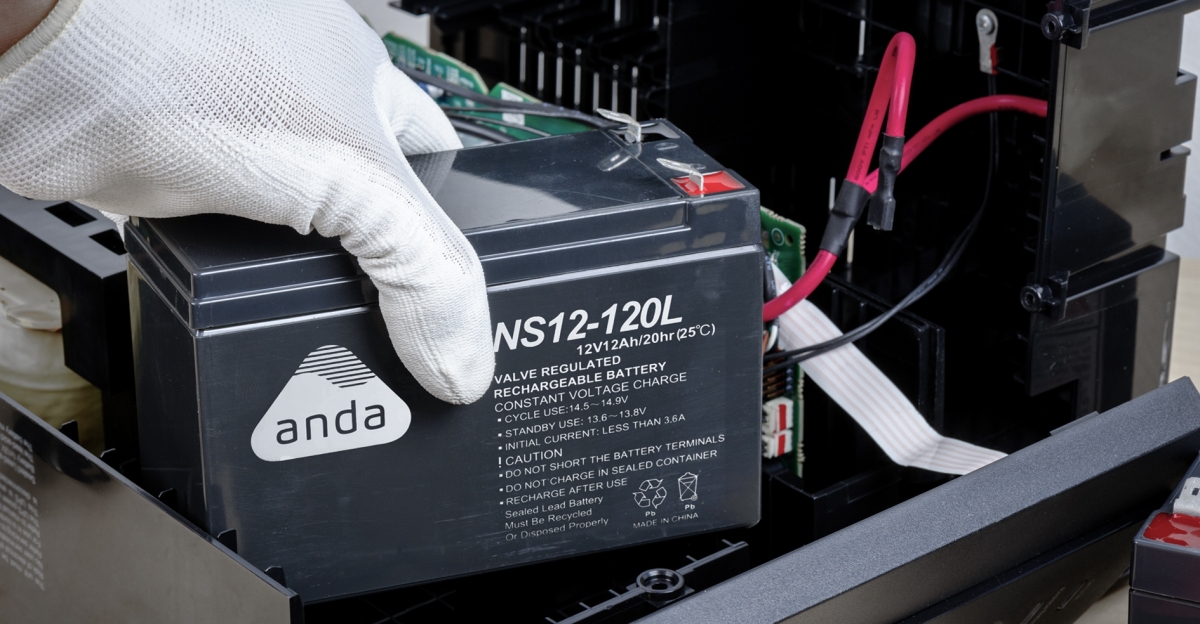Du er her: Forside -> English - > How to Choose the Right Battery for Your UPS

How to Choose the Right Battery for Your UPS
Publisert 20.12.2024
The battery is the heart of your UPS - here's how to choose the right one!
How to Choose the Right Battery for Your UPS
The battery in a UPS (Uninterruptible Power Supply) is critical for ensuring stable operation during power outages and voltage dips. With the right battery, you can extend your system's lifespan and protect vital equipment. This guide provides an overview of battery types, how to calculate capacity, and tips for prolonging battery life.
Why Are UPS Batteries So Important?
UPS systems ensure that critical electronic systems remain operational during power outages. A reliable battery provides the energy needed to save data, safely shut down equipment, or keep systems running until power is restored. Battery capacity and reliability minimize the risk of data loss and physical equipment damage.
Battery Technologies: AGM vs. Lithium
When selecting a battery technology for a UPS, the choice often comes down to AGM batteries or lithium batteries, each with unique advantages suited to different applications.
AGM Batteries (Absorbent Glass Mat)
A type of lead-acid battery (VRLA) widely used in UPS systems today.
Cost-effective and durable.
Minimal maintenance, with good resistance to vibration and temperature fluctuations.
Ideal for standard UPS solutions where power outages are infrequent.
Lithium Batteries
Higher initial cost but lower TCO (Total Cost of Ownership) due to longer lifespan and better performance.
Exceptional durability, handling significantly more charge-discharge cycles than AGM.
Perfect for environments with frequent power outages or demanding operations, where reliability and long-term cost-efficiency are critical.
AGM vs. Lithium - Key Differences
When comparing AGM and lithium batteries, consider TCO (Total Cost of Ownership) and specific needs:
Cost: AGM has a lower upfront cost, but lithium compensates with a longer lifespan and reduced maintenance.
Performance: Lithium batteries withstand far more charge cycles and provide stable performance over time.
Applications: AGM is ideal for standard use with rare outages, while lithium excels in frequent-outage environments.
What Should You Choose?
The choice of battery technology depends on the requirements of your specific environment:
AGM Batteries: Cost-effective and straightforward for standard UPS use.
Lithium Batteries: The best choice for demanding environments where longevity and reliability are essential.
For frequent outages, lithium stands out as the optimal choice due to its superior charge and discharge cycle capabilities and overall long-term cost efficiency.
How to Calculate Capacity
To select the right battery for your UPS, determine your equipment's power needs and how long the UPS should support it. Use this simple formula:
Load (in watts) × Desired runtime (in hours) = Required capacity (in watt-hours)
Example: For a 300W load with 2 hours of runtime:
300W × 2 hours = 600Wh.
You'll need a battery pack with at least 600Wh capacity.
Keep in mind that this formula is a guideline and doesn't account for factors like the Peukert effect, temperature, or battery age, which can significantly reduce performance.
What Is the Peukert Effect?
The Peukert effect explains how available capacity in a lead-acid battery decreases with higher discharge rates. Battery capacity is typically specified for a particular discharge time, such as 10 hours (C10) or 20 hours (C20).
Example: For our NF12-100 AGM battery:
100.9 Ah at a 10-hour discharge rate (C10).
105.8 Ah at a 20-hour discharge rate (C20).
If the battery is required to deliver higher power over a shorter time, the available capacity will be lower than specified.
Prolonging Battery Life
UPS batteries have limited lifespans, but proper maintenance can significantly extend their usability.
Tips for Extending Battery Life
Avoid deep discharges: Don't let the battery run completely empty, as this can permanently reduce capacity.
Storage and usage: Keep the battery at a stable temperature, ideally between 20-25 °C.
Regular testing: Perform periodic checks to ensure optimal battery performance.
When Should You Replace Your UPS Battery?
UPS batteries have finite lifespans, so it's essential to know when to replace them:
Lifespan: Smaller batteries (1-30 Ah) typically last 3-5 years, while larger or "long-life" batteries last 6-10 years.
When to replace: Replace the battery when capacity noticeably drops or at the manufacture's recommended interval.
Safety First!
When installing and maintaining UPS batteries, prioritize safety:
Wear protective gear: Gloves and safety goggles protect against potential acid splashes.
Avoid short circuits: Handle battery cables carefully to prevent sparks or damage.
Proper disposal: Return used batteries to Anda-Olsen or an authorized recycling facility.

Handling Larger Batteries
Weight: Large batteries can be heavy - use two-person lifts to reduce injury risks.
Work and safety footwear: Wear safety shoes to protect against dropping or slipping batteries.
Lifting aids: Anda-Olsen offers battery lifts for safer handling.
Need Help Choosing the Right Battery?
Our team is ready to help you find the perfect solution. Contact us today for advice and guidance - we're here to ensure you get the best option for your specific needs.
With the right choice and maintenance of batteries, you can ensure uninterrupted and efficient operations, no matter the circumstances.
Relevant blog-posts:
- Why do you need an UPS?
- Pros and Cons of Lithium Batteries
- Ensuring UPS efficiency: 4 maintenance tips